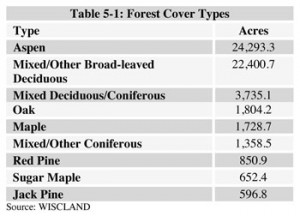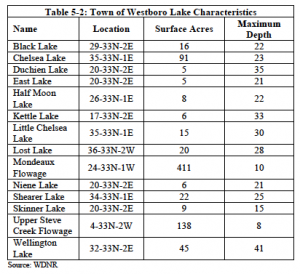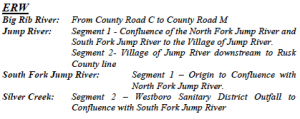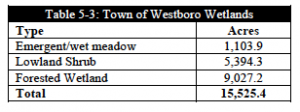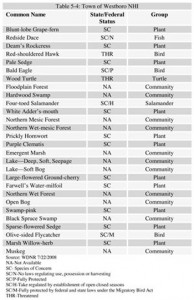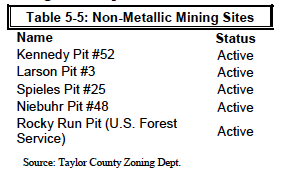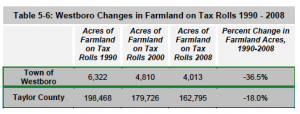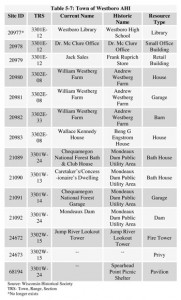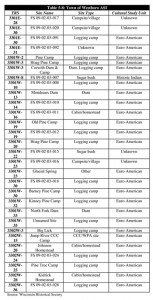This element of the comprehensive plan provides an inventory and assessment of the natural, agricultural, and cultural resources of the Town of Westboro. Land development patterns are directly linked to the resource base; therefore, these features need to be considered before making decisions concerning future development in the town.
Natural Resources
The resource base found within Westboro is susceptible to irreversible damage through inappropriate land use, transportation, public facility and economic development, point and non-point pollution sources, and a variety of other threats. The town planning effort must therefore acknowledge the current resources found throughout the town and understand that these resources are limited, and that future development must be properly planned so that serious and costly environmental problems can be
prevented and to ensure that these resources remain available for future generations.
Topography and Elevation
The Town of Westboro and Taylor County are part of the Northern Highland Geographical Province of Wisconsin. This region is characterized by an abundance of forest, hills and lakes. The elevation of the town ranges from a low of 1,269 feet to a high of 1,781 feet. See Map 5.1, Elevation and Topography.
Slope
Steeply sloping lands are usually characterized as those areas in excess of 15-20 percent vertical rise. Slope analysis is an important development consideration, as steep slopes can be potentially dangerous and/or unusable. Steep slopes in the Town of Westboro are generally located adjacent to water bodies. Map 5.2 shows slope in the Town of Westboro from zero to greater than 20 percent.
Soils
The use and management of soils has many impacts on the communities in Taylor County. Soils form the foundation that all other ecosystems are dependent on – plant life, wildlife, streams, wetlands and lakes. Soils also may pose limitations to the use of the land in activities such as agricultural production, forestry, building development and road construction.
Taylor County soils information is available through the Natural Resource Conservation Service (NRCS). The NRCS has grouped the soils of Taylor County into soil series. Soil suitability is a key factor in determining the best and most cost-effective locations for development. Soil type capabilities also foretell the viability of land for agricultural purposes. The Town of Westboro has six general soil series that are a combination of two or more soil types, which are shown on Map 5.3 and summarized below.
Almena – Very deep, somewhat poorly drained soils ranging in depth from 36 – 60 inches to loamy till. These soils formed mostly in loess or silty alluvium and in the underlying loamy till on ground moraines.
Antigo – Very deep, well drained soils which are moderately deep to sandy outwash. These soils formed mostly in loess or silty alluvium and in loamy alluvium underlain by stratified sandy outwash.
Auburndale – Very deep, poorly drained soils formed mostly in loess or silty alluvium, or both, and in the underlying loamy till on ground moraines.
Cable – Very deep, poorly drained and very poorly drained soils that are moderately deep to a densic contact. These soils formed in a thin loess or water-laid loamy mantle and in loamy till underlain by dense mostly sandy lodgement till. These soils are in depressions or drainage ways on drumlins.
Cathro – Very deep, very poorly drained organic soils moderately deep to loamy materials. They formed in organic material 16 to 51 inches thick overlying loamy glacial deposits on ground moraines, end moraines, outwash plains, lake plains, stream terraces, and floodplains.
Chetek – Very deep, somewhat excessively drained soils which are shallow to sandy outwash. They formed mostly in loamy alluvium and in the underlying sandy and gravelly outwash. Typically, they are on outwash plains and stream terraces but some are on moraines or kame terraces.
Loxley – Very deep, very poorly drained soils formed in herbaceous organic deposits more than 51 inches thick in depressions on moraines, lake plains and outwash plains.
Lupton – Very deep, very poorly drained soils formed in organic deposits more than 51 inches thick within depressions on lake plains, moraines and outwash plains.
Magnor- Very deep, somewhat poorly drained soils which are deep to a densic contact. They formed in loess or silty lacustrine deposits and in the underlying dense sandy loam till mostly on ground moraines, end moraines, disintegration moraines, drumlins, and ice-walled glacial lake plains.
Menahga – Very deep, excessively drained to well drained soils that formed in sandy glacial outwash sediments on outwash plains, valley trains, and some moraines and drumlins.
Newot- Very deep, well drained soils that are deep to a densic contact. They formed in loamy till on end moraines, disintegration moraines, ice-walled glacial lake plains, and drumlins.
Pence- Very deep somewhat excessively drained soils which are shallow to stratified sandy outwash. They formed in a thin mantle of loamy alluvium or eolian deposits and in the underlying stratified sand or stratified sandy outwash on glacial lake plains, outwash terraces, outwash plains, eskers, and kames within moraines.
Langlade- Very deep, well drained soils formed in a mantle of loess or silty alluvium and in loamy alluvium overlying sandy and gravelly outwash on outwash plains.
Rifle- Very deep, very poorly drained soils formed in organic deposits more than 51 inches thick in bogs and depressional areas within ground moraines, end moraines, outwash plains, and lake plains.
Rosholt- Very deep, well drained soils which are moderately deep to sandy outwash. These soils formed mostly in loamy alluvial deposits and are underlain by stratified sandy outwash on outwash plains, stream terraces, eskers, and kames.
*Source: USDA Official Soil Series Descriptions
Land Cover
Land cover information for the Town of Westboro was obtained from the Wisconsin Initiative for Statewide Cooperation on Land Cover Analysis and Data (WISCLAND) data set. This data represents surface vegetation, open water and urban area delineation based on interpretation of satellite imagery. The data represents a generalized picture of land cover and should not be used to replace site examinations. WISCLAND land cover is depicted on Map 5.4.
Forests
Forest is the most prominent land cover in the Town of Westboro, as it represents significant environmental, cultural, social and economic assets to residents and visitors. Forests provide many benefits, including wildlife habitat, forest products, recreational opportunities, aesthetics and other benefits that cannot be quantified.
The Town of Westboro has approximately 46,312 acres in the Chequamegon-Nicolet National Forest. This land was purchased during the depression years of the 1930’s. Also at this time, Taylor County took over logged off marginal land by tax title. The township receives a share of the timber stumpage taken from National Forest acres within the town. Management policies of the Forest Administrators and Federal lawmakers have a great influence on forest income to the town.
The dominant forest cover type in the Town of Westboro is aspen, which comprises 24,293.3 acres of the total forested area. Mixed/other broad-leaved deciduous forest makes up the bulk of the remaining forestland in the town. Map 5.5 displays forest cover and Table 5-1 lists the forest cover types found in Westboro and their approximate acreages.
Approximately 60 percent of forestland in the Town of Westboro is currently under public ownership as part of the Chequamegon-Nicolet National Forest, and is located in the western three-quarters of the town.
Surface Water Resources
Water resources in the Town of Westboro are environmentally, socially and economically significant. These resources represent unique and complex ecosystems that extend beyond the confines of lakes, rivers or streams and impact the surrounding terrestrial environment. Town of Westboro hydrology is shown on Map 5.6.
Within the Town of Westboro, there are 14 named and 24 unnamed lakes with approximately 42.1 miles of shoreline. Named lakes tend to be larger and deeper than most unnamed lakes in the town. The largest lake is the Mondeaux Flowage at 411 acres, and the deepest lake is Wellington Lake, at 41 feet. In the entire county, there are 283 named lakes and only 19 are greater than 50 acres. Table 5-2 includes lake characteristics for the named lakes in the Town of Westboro.
Rivers, creeks and streams also represent diverse and unique systems. Human and land use activities are intimately linked to the quality of these water resources. There are approximately 111 miles of perennial and intermittent rivers, creeks and streams in the Town of Westboro. The main rivers include the Mondeaux, North Fork Yellow, and Black.
Water Quality
The water quality in the Town of Westboro is generally excellent. The large amount of forestland in the town limits the total amount of surface runoff, helping to keep water quality high. The WDNR evaluated surface waters in the state based on water quality, fish, wildlife, and aesthetic values. Some water bodies were proposed for designation in Chapter 102, Wisconsin Administrative Codes, (Water Quality Standards for Wisconsin Surface Waters), as Outstanding Resource Waters (ORW). This designation allows for special protection as these water bodies were rated as having high quality values as stated above. Other water bodies may have been rated as Exceptional Resource Waters (ERW). These were similar to ORWs in characteristics, but did not score as high in the ranking system. ORWs get the highest protection possible under Wisconsin law. Any discharges into ORW must be as clean as the background water quality.
Several streams or rivers in the county have been identified as ORW or ERW. In some cases the stream or river segment classified traverses more than Taylor County as identified in the segment description. The segments identified are from NR 102.10 (November 2006).
Impaired waters, as defined by Section 303(d) of the federal Clean Water Act, are those waters that do not meet the state’s water quality standards. Every two years, states are required to submit a list of impaired waters to EPA for approval. In 2008, WDNR developed a proposed Impaired Waters List update. Eight water resources were identified in Taylor County. All were polluted with mercury, had a low priority rating, and had fish consumption advisories. In the Town of Westboro, no water bodies made the 303d list.
Watersheds
A watershed is an interconnected area of land draining from surrounding ridges to a common point such as a lake, stream or wetland. Four watersheds encompass the Town of Westboro. Most of the town is part of the Upper South Fork Jump River and Upper Yellow (Wood Co.) River watersheds. Portions of the town are in the Middle Jump River and the Black and Little Black Rivers watersheds. A very small portion of the town is included in the Upper Rib River watershed. See Map 5.7 for watersheds in the Town of Westboro.
Floodplains
Floodplains are lands adjacent to lakes, rivers and streams, which are subject to periodic and/or recurring flooding. Due to the flood-prone natures of these areas, development and other land use activities within these zones are discouraged. Resource protection and wildlife habitat uses would be considered appropriate uses for these areas.
The Federal Emergency Management Agency (FEMA) has defined areas of flood susceptibility in the Town of Westboro. Flood prone areas were determined by statistical analysis of records of river flow, rainfall information, floodplain topographic surveys, and hydrologic analysis. Taylor County has developed a floodplain zoning ordinance (Chapter 29) to regulate development in flood hazard areas to help protect life, health and property within the county. Determination as to whether a present or future building site is located in a floodplain must be made through the Taylor County Zoning Department office maps or through field verification of flood boundaries. Floodplains in the Town of Westboro are depicted in Map 5.8.
Groundwater
Groundwater is a critical resource for the Town of Westboro, as it is the main source of drinking water for town residents. Throughout most of the town, the depth to the groundwater is 0-20 feet; however, a large area near the center of the town, and another area on the east side of the town have depths ranging from 21-50 feet. In a few smaller areas of the town, the depth to groundwater is greater than 50 feet. The quality of groundwater varies by location and is directly related to human activities such as the application of fertilizers, chemical spills, urban runoff, and non-point pollution. These factors can contribute to decreased quality of groundwater reserves.
Since 1985, the Taylor County Land Conservation Department and UW-Extension have conducted drinking water testing that has painted a general picture of the quality of groundwater around the county. Testing has been conducted for coliform bacteria, nitrates, chlorides and arsenic. Arsenic is one of the most serious potential health threats in Taylor County’s drinking water. Elevated levels of arsenic are found in drinking water tested throughout the county, with the highest levels in the northern half of the county.
Wetlands
A wetland is an area where water is at, near, or above the land surface long enough to be capable of supporting aquatic or water-loving vegetation and which has soils indicative of wet conditions. Wetlands are commonly referred to as swamps, marshes, lowland or bogs. They represent one of the most unique and diverse components of the natural community. The WDNR has an inventory of wetlands of five acres and larger. There are three wetland types in the Town of Westboro. These include forested, emergent/wet meadow and lowland shrub wetlands. See Map 5.9, Wetlands. Table 5-3: Town of Westboro Wetlands.
Threatened or Endangered Species
Wisconsin law prohibits the “taking” of any plant or animal listed as endangered or threatened regardless of where it occurs. Taking is defined as the act of killing, harming, collecting, capturing, or harassing a member of a protected species. The WDNR provides information of endangered and threatened species within the Bureau of Endangered Resources. This bureau also maintains Wisconsin’s Natural Heritage Inventory (NHI), which provides information and data on the locations and status of rare species, natural communities, and natural features in Wisconsin. Table 5-4 details the NHI in the Town of Westboro and Map 5.10 shows their general location.
State Natural Areas
State Natural Areas (SNAs) protect outstanding examples of Wisconsin’s native landscape of natural communities, significant geological formations and archeological sites. Wisconsin’s 418 State Natural Areas are valuable for research and educational use, the preservation of genetic and biological diversity, and for providing benchmarks for determining the impact of use on managed lands. They also provide some of the last refuges for rare plants and animals. In fact, more than 90% of the plants and 75% of the animals on Wisconsin’s list of endangered and threatened species are protected on SNAs. Mondeaux Hardwoods, Kidrick Swamp, and Silver Creek & Mondeaux River are the three state natural areas located in the Town of Westboro.
Mondeaux Hardwoods is a 2,826-acre site owned by the U.S. Forest Service. It is located along the Mondeaux River, and was designated a State Natural Area in 2007. It includes northern mesic, wet-mesic, and wet forest plant communities, as well as alder thicket, northern sedge meadow, ephemeral pond, springs and spring runs, and aquatic plant communities. The hemlock and white pine stands in this area are some of the oldest and largest in the Medford-Park Falls District of the Chequamegon-Nicolet National Forest.
Kidrick Swamp is located along Forest Road 113 near the western border of the town. It is also owned by the U.S. Forest Service and was designated a State Natural Area in 2007. This area consists of a peatland complex of black spruce and tamarack bog and black spruce muskeg within an upland hardwood forest. It is a breeding ground for neotropical migratory birds, such as the yellow-bellied flycatcher and the golden-winged warbler.
The Silver Creek & Mondeaux River State Natural Area is another site located within the Chequamegon-Nicolet National Forest. Designated in 2007, it is 541 acres and is located along the northern border of the Town of Westboro. The main feature of this State Natural Area is the old-growth floodplain forest where the Mondeaux River and Silver Creek meet. The site communities range from river floodplain to upland drymesic pine and maple forest. The site also contains small areas of black ash swamp, hemlock forest, northern mesic forest, open sedge meadow, and shrub carr.
Legacy Places
The WDNR has identified the Chequamegon-Nicolet National (CN) Forest as a place considered important to meet Wisconsin’s conservation and recreation needs over the next 50 years. In the Town of Westboro, the Federal forest covers approximately 46,000 acres. The total acreage of the Chequamegon-Nicolet National Forest covers an area close to 1.2 million acres. Legacy places have been assigned a value on a five-point scale. The CN in Taylor County scored a 5/5 on both conservation significance and recreation potential.
Non-Metallic Mineral Resources
Taylor County’s mineral resources have potentially significant economic, community and environmental impacts on local areas and the county as a whole. Mineral resources are placed into two general categories – non-metallic (e.g., sand and gravel) and metallic (e.g., gold, silver, copper). There are no active metallic extraction sites in the county. Mining sites in Taylor County are known as active (open), inactive (closed), pending and proposed. As of June 26, 2009, there were five open non-metallic mining sites and one proposed site in the Town of Westboro. The name and status of each existing nonmetallic mining site is depicted in Table 5-5.
Agricultural Resources
Agricultural lands play an important part in defining the character of communities in Wisconsin. Good planning helps rural communities promote agriculture and its contribution to rural economies, support appropriate development of land, manage renewable resources, avoid unnecessary conflicts among neighboring land uses, protect community features of special value, and encourage appropriate community development. In the Town of Westboro, about four percent of the land use is in some form of agriculture. There are dairy, beef, and other small animal farms in the town. According to the NRCS, there is little prime farmland in the Town of Westboro; however, most of the town is considered prime farmland if drained. There is also a large amount of farmland of statewide importance in the eastern portion of the town (See Map 5.11). Farmlands that are not used for farming operations are rented by other farmers for crop farming or for other personal uses. Farming helps to support the town and residents in the Town of Westboro should help farmers by supporting them any way they can.
Agricultural-related issues were addressed in the Town of Westboro Comprehensive Plan Survey. The agricultural questions and results are listed below. Results show that an overwhelming percent of property owners that responded feel it is important to preserve the agricultural industry in Taylor County.
Farmland Trends in the Town of Westboro
In the last 18 years, the Town of Westboro has lost 2,309 acres of farmland on its tax roll, a decrease of over 36 percent. In contrast, Taylor County as a whole has lost 18 percent of farmland on the tax roll in the past 18 years.
Farmland Preservation
The Farmland Preservation Program was developed in the late 1970’s and early 1980’s to achieve three goals: land conservation, tax relief for farmland owners, and land use planning.
Taylor County prepared a Farmland Preservation Plan under the Wisconsin Preservation Act in the early 1980’s. Adopted in 1981, this plan sought to preserve large blocks of farmland most suitable for agricultural production, maintain the rural character of the county, preserve open space and scenic areas, and encourage development to be directed to areas with existing public facilities (sewer and water).
Prime farmland was identified by the Taylor County Farmland Preservation Plan as all soils categorized by the Soil Conservation as having a capability class of I, II, and III and all lands presently used for agriculture (all cultivated land and pasture, not including pastured woodlots). NRCS identified prime farmland on Map 5.11 as all areas of prime farmland, farmland of statewide importance, and prime farmland if drained. The County currently has approximately 6,226 acres enrolled in 42 farmland preservation programs. Property tax relief is provided to farmland owners who participate in the programs. The soil and water preservation standards for farm plans in Taylor County are tied to the NR 151 performance standards.
Cultural Resources
A cultural resource is a broad term that can encompass much of a community’s heritage. Cultural resources may include archaeological sites and cemeteries, historic buildings and landscapes, historic transportation routes, ethnic traditions and community festivals. Cultural resources are those elements around us that signify our heritage and help to evoke the sense of place that makes an area different or distinctive.
National Register of Historic Places
There is one property in the Town of Westboro listed on the NRHP. This property is the Mondeaux Dam Recreation Area. The site is roughly bordered by the Mondeaux River and Forest Road. The dam and flowage were built in the 1930s, and the 400-acre recreation area followed. The recreation area is known for the excellent birding opportunities available.
The Wisconsin Historical Society maintains the Wisconsin Architecture & Historic Inventory (AHI) that identifies any properties that may have been surveyed in the past. The inventory does not convey special status and may not be current. Table 5-7 lists the 14 historic properties listed in the AHI database for the Town of Westboro. It should be noted that the historic Westboro Library is no longer in existence, but is still in the Historic Society’s inventory. For more information on these sites they may be reviewed in more detail at www.wisconsinhistory.org/ahi.
Archaeological Sites Inventory
The Wisconsin Historical Society also maintains a list of archaeological sites and cemeteries known as the Archaeological Site Inventory (ASI) database. Up to this point in time, 30 archaeological sites have been reported for the Town. Types of sites that have been identified include campsites/villages, cabins/homesteads, dams and logging camps. Table 5-8 details the 30 sites reported in the Town of Westboro.
Natural, Agricultural and Cultural Resource Protection Programs
To help implement this plan element, the Town of Westboro may use the following list of programs and tools. This list is not comprehensive. Many other local, state, and Federal programs may exist.
Natural Resource Programs
Runoff Management Programs
The Wisconsin Department of Natural Resources administers two grant programs to support both the implementation of source-area controls to prevent runoff contamination and the installation of treatment systems to remove pollutants from runoff. The Targeted Runoff Management Program (TRM) provides a 70 percent cost share, up to $150,000 to target high priority resource problems.
- Construction of urban and rural BMP’s
- 2 year grant period
- Site-specific
The Urban Nonpoint Source & Storm Water Management (UNPS&SW) Grant Programs are used to control runoff in urban areas, with a population density of 1,000 people per square mile.
Lake Planning Grants
The Wisconsin Department of Natural Resources administers a number of lake management financial assistance programs designed to assist local units of government.
Small Scale Lake Planning Grant
Available to local units of government, including public inland lake protection and rehabilitation districts, town sanitary districts, and other local governmental units as defined in Wis. Stats. Ch. 66.0301.
- Funds may be used to collect and analyze information needed to protect and restore lakes and their watersheds.
- 75 percent cost share
- Total project cost not to exceed $3,000
Self-help Trend Monitoring Grant
- Total project cost not to exceed $3,000
- Grantees provide voluntary labor (130 hours) for lake monitoring activities
- WDNR provides materials and laboratory analysis
Large Scale Lake Planning Grants
Available to local units of government, including public inland lake protection and rehabilitation districts, town sanitary districts, and other local governmental units as defined in Wis. Stats. Ch. 66.0301.
- 75 percent cost share project
- Total cost not to exceed $10,000
- Funds can be used for collecting lake data, analysis of land uses, analysis of ordinances, resource assessments, or developing components of a lake management plan.
Lake Protection Grants
Administered by the Wisconsin Department of Natural Resources, the Lake Protection Grants Program is designed to fund large-scale lake protection projects.
- Available to local units of government, including public inland lake protection and rehabilitation districts, town sanitary districts, and other local governmental units as defined in Wis. Stats. Ch. 66.0301.
- 75 percent cost share
- Maximum award of up to $200,000
Eligible projects include:
- Purchase of land or easements
- Restoration of wetlands or shoreland
- Development of ordinances or regulations
- Implementation of lake management plan projects
Wisconsin Forest Landowner Grant Program (WFLGP)
This is a state program administered by the WI Department of Natural Resources (DNR). Cost shares up to 50 percent (maximum $10,000 per year) are available for:
- Development of management plan
- Tree planting (site prep, planting stock, planting, etc.)
- Timber stand improvement
- Fencing
- Soil and water protection
- Wildlife practices
- Fisheries practices
- Buffer establishment
- Threatened and endangered species protection
- Historic and aesthetic enhancement
Stewardship Incentives Program (SIP)
This federal program, administered by WI DNR and Farm Service Agency (FSA), provides up to 65 percent cost share for:
- Development of management plan
- Tree planting (site prep, planting stock, planting, etc.)
- Timber stand improvement
- Fencing
Conservation Reserve Program (CRP)
This federal program, administered by FSA and Natural Resources and Conservation Services (NRCS) with WI DNR inputs, provides annual payments and up to 50 percent cost share for:
- Development of management plan
- Tree planting (site prep, planting stock, planting, etc.)
- CRP is currently focused on wildlife enhancement and does not allow solid plantations SRIC Poplars. The State of Wisconsin currently does not allow hybrid poplar to be planted under any CRP contract because it is not native to the area. However, pure cottonwoods are acceptable. Allowable species varies with each state. Please consult your local NRCS and/or FSA office for details.
Forestry Incentives Program (FIP)
This federal program, administered by NRCS with DNR inputs, provides up to 65 percent cost share for:
- Development of management plan
- Tree planting (site prep, planting stock, planting, etc.)
Managed Forest Law (MFL)
This Wisconsin state program is entirely administered by the WDNR and provides the landowner a significant property tax reduction. The actual property tax paid will depend upon if the land is open or closed to the public. Upon harvest, a stumpage tax must be paid to the state, based on the average stumpage price. The program is targeted towards:
- Development of management plan
- Tree planting (site prep, planting stock, planting, etc.)
- Timber stand improvement
Wildlife Habitat Incentives Program (WHIP)
This federal program, administered by NRCS with WI DNR inputs, provides up to 75 percent cost share with emphasis towards:
- Wildlife practices and plantings
- Wetland restoration
- Farmstead shelterbelts
- Grazing systems
Environmental Quality Incentives Program (EQIP)
This federal program is administered by NRCS with WI DNR inputs and provides up to 75 percent cost share for:
- Priority areas
- Tree planting for erosion control, agricultural waste management, stream buffers, ecosystem management, etc.
Agricultural Resource Programs
Wisconsin Department of Revenue Farmland Preservation Programs
Wisconsin’s Farmland Preservation Credit Program seeks to preserve Wisconsin farmland by means of local land use planning and soil conservation practices and to provide property tax relief to farmland owners. To qualify for the credit, farmland must be 35 acres or more and zoned for exclusive agricultural use or be subject to a preservation agreement between the farmland owner and the state.
The Farmland Tax Relief Credit Program provides direct benefits to all farmland owners with 35 or more acres. The credit is computed as a percentage of the first $10,000 of property taxes up to a maximum credit of $1,500.
Wisconsin Farmland Protection Program (FRPP)
Farm and Ranch Lands Protection Program keeps productive farmland in privately owned agricultural use by assisting states, tribes, and local government or non-profit entities with the purchase of conservation easements or development rights on productive farmland and on farms containing significant historical or archaeological resources. Under this program, the Natural Resources Conservation Service will provide up to 50 percent of the purchase cost for perpetual easements on eligible farmland.
Cultural and Historic Resource Protection Programs
Wisconsin Historic Preservation Fund Subgrants (Tax Credits)
Historic Preservation Fund (HPF) subgrants are administered by the Wisconsin Historical Society’s Division of Historic Preservation (DHP). These grants are in the form of income tax credits for income-producing historic buildings, historic homes, and archaeological sites. These credits are available to all local units of government in the State of Wisconsin and to non-profit organizations.
Wisconsin Humanities Council Historic Preservation Grants
The Wisconsin Humanities Council offers grants of up to $10,000 for projects that enhance appreciation of the need for historic preservation and/or increase public awareness of the importance of particular historic buildings or decorative art works in Wisconsin. Preference is given to small towns and rural communities with populations under 30,000.
National Trust for Historic Preservation/Jeffris Preservation Services Fund (PFS)
This fund was established in 1998 by a gift from the Jeffris Family Foundation to the National Trust. The PSF provides funding to small towns to use in the planning stages of historic preservation projects. Eligible expenses include costs for professional consultants and educational activities. A dollar for dollar match is required for these grants.
If you can't find what you are looking for on this website, please provide feedback.

